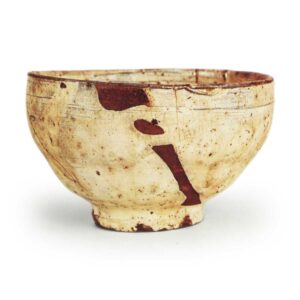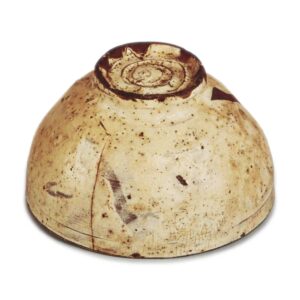

Chuko Meibutsu
Height: 7.1-8.0cm
Diameter: 11.9-13.0cm
Outer diameter of foot ring: 5.4cm
Height of foot ring: 0.9-1.0cm
The word “sohaku” is used to describe the feeling of this tea bowl, which is pure white and elegant, and it is listed as a “sohaku” tea bowl in the “Taisho Meiki Kan” (A Guide to Famous Tea Bowls from the Taisho Period), but it should probably be considered as a type of “kohiki” tea bowl. It is also referred to as an “ido” tea bowl. The “Mekirisou” (A Guide to Discerning Tea Bowls) also says, “Sohaku, Shiraito. Commonly called Sobakuito, it is owned by the Kashiu clan.” It is said that during the Edo period, no one in Edo had ever seen the Kaga Sobaku, and that a gardener who was in and out of the Kaga clan’s residence one day saw the lord of the manor looking at a tea bowl on the porch from behind a bamboo fence, and spread the word that it was a white well, which is how the Sobaku came to be known as a well. In any case, it is a rare and famous bowl. As the Taisho Meiki Kan (A Guide to Famous Tea Bowls of the Taisho Period) says, “If you were to count the famous tea bowls of the world, this bowl would surely be among the top ten,” Sohaku is a particularly outstanding, finely detailed, wabi-like tea bowl with a refined feel. In the “Maeda Family Collection”, it is written that “it is a superb piece of pottery, incomparable to any other”.
The clay is a rough clay with a high iron content, which is then covered in a white slip and a transparent white glaze is applied on top. The firing is slightly reducing, but the glaze is not as blue as that of the Miyoshi ware. There are also areas with rough craquelure, but there is no craquelure in areas with a thin glaze. The mouth is thin, the body is full and bulging, and it is similar to the shape of a sake bottle, with a tight mouth and a thick, rich body with a tight waist. The foot ring, which is made from a large bamboo joint, wraps around the bottom, and there are nine marks on the foot ring. The subtle variations in the thickness of the white slip, the areas where it is too thin and the underlying gray clay can be seen through, add to the charm of this tea bowl.
The most beautiful part of the Chohaku is the large fire mark that runs from the upper left to the lower right on the body. I have never seen a tea bowl with such a large fire mark, either in the powder-coated or other types of tea bowls. When the glaze was applied, two lines of glaze flowed across the fire mark, adding to its beauty. The Kohiki ware in the Hatakeyama Memorial Museum, which was passed down through the Mitsuyoshi family of the Mitsui clan and the former Matsudaira family of Unshu, was probably made by a potter who was left-handed, and the shape and the tone of the fire are very similar, with the fireband either running from the top right to the bottom left or from the top left to the bottom right. However, the Soseki is cut from the upper left to the lower right, and in general, the hima flows from the upper left to the lower right, as in this teacup.
The inside is also covered in white makeup, and there are shallow lathe marks on the inside. There are three vertical grooves of different sizes, but there are no particular flaws.
Bag: Arisugawa-style cloth, inside: tea-colored lacquer
Inner box: tamenuri lacquer
Outer box: paulownia wood, plain finish
It is said that this item has been in the possession of the Maeda family of Kaga since ancient times, but it is not clear who owned it before that.



